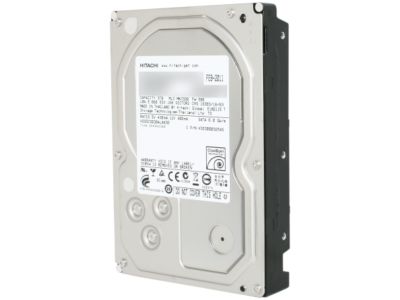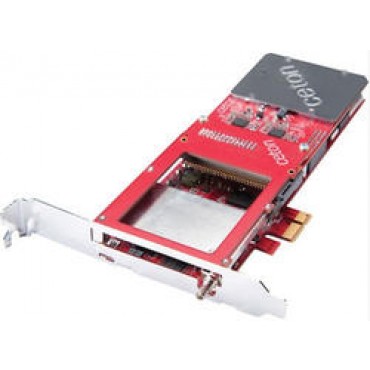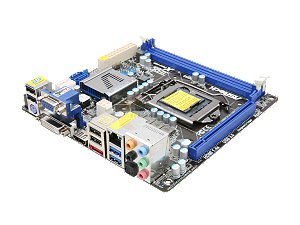Holiday 2011 Mainstream High-End Buyer's Guide
by Zach Throckmorton on December 9, 2011 12:00 AM EST- Posted in
- Guides
- AMD
- Intel
- Sandy Bridge
- CrossFire
- Sandy Bridge E
- Holiday 2011
- NVIDIA
Cinematastic SFF HTPC
I covered small form factor home theater PCs in May, offering both Intel- and AMD-based systems. Both of those rigs came in well under $1000. This guide's HTPC is substantially more capable in every regard, with a price tag to show for it. This SFF HTPC has four primary considerations in mind with its design: video transcoding capability, plenty of storage space for a large media library, Blu-ray playback, and finally the ability to serve as a cable box DVR replacement.
The best video transcoding CPU available on the mainstream market today is without a doubt the Intel Core i7-2600K. You can check out AnandTech's Bench for a good idea of how this chip performs in a wide variety of tasks. Further, Anand thoroughly reviewed the CPU at the start of 2011 upon its launch. It is important to note that the i7-2600K is total overkill for simple HD media playback—that can be accomplished easily by a CPU costing less than $100. Thus, this HTPC is capable of not just media playback, but extremely fast media encoding/transcoding as well.

The tragic flooding throughout southeast Asia, particularly Thailand, has caused a severe disruption of the global hard drive supply chain. It is a bad time to invest in many high capacity hard drives, but if you want to build a computer that can store terabytes of files, you have little choice. Unfortunately, we do not yet know when hard drive prices will return to their pre-flood levels, though it will likely be months from now. Therefore we're dropping over $500 on 6TB of mass storage in the form of two Hitachi HDDs. It's difficult to pay that much for drives that were half that price only months ago, so if you can put off buying lots of storage for several months, you should considering doing so.

As for Blu-ray playback and cable box DVR replacement, we're going with a standard LITE-ON Blu-ray burner that supports 3D BR-Ds and a Ceton InfiniTV quad-tuner. The Blu-ray burner costs about twice as much as Blu-ray readers, so if you are not interested in burning BR-Ds, you can save some money by foregoing that capability. Note that this is an OEM drive—you will have to purchase appropriate software or use a freeware application with it. (My personal favorite freeware BR-D player is Media Player Classic - Home Cinema, but there are others that also work well.) The Ceton InfiniTV essentially acts as a replacement for four cable boxes, allowing you to view and/or record up to four HD cable programs simultaneously. This is a very powerful card when combined with a LAN. It can certainly serve as a centralized multistream HD cable player for an entire household, and it works without issue with Windows 7's Media Center.

We've selected ASRock's Z68M-ITX/HT mini-ITX motherboard to tie all of the components together. This is a very feature-rich ITX board that includes both HDMI out as well as DVI and optical S/PDIF interfaces. As it is a Z68-chipset board, it also supports the i7-2600K's impressive overclocking abilities. The only real limitation of the board is its sole PCIe x16 lane. The Ceton tuner card uses a PCIe x1 interface, which can be up-plugged without issue into the ASRock board. However, if the Ceton tuner is in place, there are no additional expansion slots—and with only four SATA ports, you are limited to four total SATA devices. In this case, the Blu-ray drive, an SSD boot and application drive, and two mass storage HDDs.
For the SSD, we're recommending Crucial's M4 128GB SATA III drive. These drives have a reputation for reliability and while not the fastest SSDs, they fare quite well against the competition. We're opting for a 128GB capacity SSD primarily to accomodate potentially large video encoding software suites, like Adobe's CS5.5 Master Collection. If you don't need as much space for your OS and application drive, you can save about $100 by going with the 64GB variant.
Because the ITX board has only two DDR3 slots, we're limited to 8GB (a single 2x4GB kit) unless you're interested in spending substantially more money on a 2x8GB kit of DDR3. For example, CS5.5 can frequently eat more than 8GB of RAM when I'm transcoding HD video, but whether a 16GB kit is worth more than a $100+ cost increase compared to an 8GB kit will depend on your particular software usage.

Powering everything we have Silverstone's Strider Plus ST50F-P PSU. This model is one of the smallest ATX power supplies, and its full modularity cuts down on cable clutter. You can read more about this excellent PSU in Martin's recent review. Finally, housing all of these components is Lian-Li's venerable PC-Q08A. This has proven to be my favorite ITX case for a number of reasons. First, I think it looks very nice. Second, the combination of the 140mm front intake fan and 120mm top exhaust fan means it runs cool for an ITX box. It is somewhat large for an ITX chassis so stuffing all of these components into it will be challenging (as all ITX builds are) but not maddeningly difficult (as some ITX builds can be, especially for those of us with larger hands). Don't worry—the stock i7-2600K CPU cooler clears the bottom of the PSU with some headroom to spare in the PC-Q08A. Finally, it should be noted that the PC-Q08 is available in black and red as well as the silver chassis in the list below.
| Component | Product | Price |
| CPU | Intel Core i7-2600K | $320 |
| Motherboard | ASRock Z68M-ITX/HT | $120 |
| RAM | Crucial 8GB (2x4GB) DDR3 1333 | $40 |
| SSD | Crucial M4 128GB | $210 |
| HDDs | (2) Hitachi Deskstar 3TB 5400rpm | $520 (total) |
| TV tuner card | Ceton InfiniTV Quad-tuner | $294 |
| Optical drive | LITE-ON IHBS112-29 | $100 |
| Power supply | Silverstone Strider Plus ST50FP-P 500W | $80 |
| Case | Lian-Li PC-Q08 | $110 |
| Operating system | Microsoft Windows 7 Home Premium 64-bit (OEM) | $100 |
| Total: | $1894 | |
If you're more interested in using your PC to play video games than movies, we have a system for you on the next page.










52 Comments
View All Comments
methudman6 - Friday, December 9, 2011 - link
I really like the Work PC build. I was wondering though, any reason to choose the Crucial ssd over an Intel 320 series? I know that Crucial m4 is sata III, but do you believe Crucial to be as reliable as Intel?Z Throckmorton - Friday, December 9, 2011 - link
In the absence of hard data from controlled studies, it's difficult to asses which products of any type, including SSDs, are the most reliable. We have to rely on anecdotal evidence from forums, reviews on retail sites, and coverage from recognized authorities like Anand. And sadly the plural of anecdote isn't data! That said, my personal opinion is that I would be comfortable running both M4s and 320s, as well as Samsung 830s. I have an M4 in my netbook and a 320 in my daily driver desktop, and none of my clients have experienced issues with either of these drives. FWIW.Vikendios - Friday, December 9, 2011 - link
If you are going to spend hours immersing in Skyrim, the glory of what you see comes first. A 30 inch monitor running at 2650 x 1900 with full effects is such a quantum leap from anything else that I cannot imagine calling "high end" anything without,It is precisely like building an audiophile music systems. What makes the sound ? The speakers. That's where the money should go, and all the rest is just support electronics.
Running 2650 x 1900, a single 580 is quite unsufficient. My rig has a two-chip 590 because I'm lazy at setting up SLI's or triple card systems. Where you can save is memory : 6 G is ample for most games, and SSD's. A good old harddrive will work fine, you won't see the difference.
The second most important luxury is silence, so you can enjoy perfect audio. I toyed with liquid cooling, but ended up solving radically the problem by leaving the innards in a closet on the other side of the wall from my den. Only a small hole in the wall behind my desk to thread cables for the monitor, the keyboard and the mouse. The sound is hooked to the hifi system in my room. Added benefit : no case neede, all components just sit on a shelf.
Enjoy.
Zap - Friday, December 9, 2011 - link
The Lian Li PC-Q08 is to me a curious choice for an HTPC case. There are many great looking HTPC cases out there that fits in better with the typical home theater equipment. My home theater has a receiver, DVD player, CD player and cable company provided digital tuner that are all around the same width. A micro tower would look decidedly out of place in that mix. My own HTPC uses a Lian Li PC-C50B which is "officially" an HTPC case and is the same size as all the rest of the equipment. Other nice cases which I considered are the Silverstone Grandia series and even the Silverstone Milo. Those would all fit in with the other equipment. So, why the micro tower?mino - Saturday, December 10, 2011 - link
A good way to show your incompetence.yorkman - Monday, December 12, 2011 - link
I'm stuck with this dilemma...I'd like to build a system that Rybka Aquarium (chess engine) will really take advantage of. It eats up whatever cores you have so the more the better.The rig in this guide is something I'm considering...but I'm not sure how much I'd benefit over the 2600K setup, or especially 2500K when used with Rybka for 24x7 analysis. Going with the 3930K would be considerably more expensive. The cpu alone is about $350 more, plus the mobo is about $100 more than the mobo for the 2500/2600.
I've been using Rybka for years and I noticed the higher you clock your cpu the stronger it is, for obvious reasons. So overclocking will be a must. I haven't seen any benchmarks for an overclocked 3930X so it's hard to guess. I'd also be using 6 man tablebases would be where I'd need at least 16 GB of ram.
I'm told Rybka doesn't take advantage of hypter-threading so the 2500K seems to be more logical...but less cache and slightly slower clock than the 2600K. Plus I do the occasional video editting in Pinnacle Studio so 2600K might be better regardless.
How much would you recommend the 3930K in my situation? Or would I be better off still with the 2500 or 2600? Perhaps there's yet another cpu I've not mentioned? I know I could go Xeons but that's way over my budget I think.
vishnusivathej - Monday, December 12, 2011 - link
totol 24CPU cores,
24Gigs of RAM
ASUS KGPE-D16 SSI EEB 3.61 Server Motherboard Dual Socket G34 AMD SR5690 DDR3 800/1066/1333
Item #: N82E16813131643
Return Policy: Standard Return Policy
Protect Your Investment (expand for options)
$429.99
Crucial 8GB (2 x 4GB) 240-Pin DDR3 SDRAM DDR3 1333 (PC3 10600) ECC Registered Server Memory Model CT2KIT51272BB1339
Item #: N82E16820148354
Return Policy: Memory Standard Return Policy
$299.97
($99.99 each)
Corsair Force Series GT CSSD-F120GBGT-BK 2.5" 120GB SATA III Internal Solid State Drive (SSD)
Item #: N82E16820233191
Return Policy: Limited Replacement Only Return Policy
Protect Your Investment (expand for options)
-$60.00 Instant
$30.00 Mail-in Rebate Card
$249.99
$189.99
AMD Opteron 6234 Interlagos 2.4GHz Socket G34 115W 12-Core Server Processor OS6234WKTCGGUWOF
Item #: N82E16819113030
Return Policy: CPU Replacement Only Return Policy
Protect Your Investment (expand for options)
$779.98
($389.99 each)
Subtotal: $1,699.93
yorkman - Monday, December 12, 2011 - link
I assume this was directed at me?Problem with that is, yes, I'd get 24 cores for an extra $1100 or so...but this is the deal breaker in my opinion...it's 2.4GHz*2=4.8GHz...something I could achieve with one 2600K cpu alone when overclocked.
The server cpu's usually can't be overclocked...so that means I'm getting 20 extra cores which is awesome, and roughly the same speed as a 2600K would get me. But it'd use up more power per month and $1100 more...plus I can't even find these parts locally which means I'd have to order them from who knows where...then add shipping on top of that and hope that no parts come in as dead on arrival.
Not sure that's a better pc. Where did you look up the prices for this? I'm in Canada so I'd prefer to order from here and not go through the border (duty fees are extra and would cost an arm and a leg extra on top of the $1100). Definitely not worth it then.
yorkman - Monday, December 12, 2011 - link
Ok, I see those quotes are from newegg.com...but since I'm in Toronto, they are not available to me (cpu). The mobo is at newegg.ca, but it's deactivated anyway.Checked on eBay....only available to customers in the U.S. so I don't think this is even an option for me.
It's got me curious on how much stronger Rybka 4 would run though given the extra 18-20 cores...but same clock speed.
Without the ssd drive, and if this can be purchased from Canadian customers somewhere....it's $1500+tax which would work out to about $1700 all in minus shipping. I'm not considering duty fees because I wouldn't pay them so I wouldn't order them from outside Canada.
And wouldn't this mobo be a better deal Supermicro H8DGU Server Motherboard - AMD - Socket G34 LGA-1944. It's about $100 cheaper when compared to the Asus in CDN dollars.
yorkman - Monday, December 12, 2011 - link
One more thing. This one would probably benefit me more:AMD Opteron 6234 2.60 GHz Processor - Socket G34 LGA-1944
as apparently Rybka 4 doesn't take advantage of HT, and can even slow it down...so with this dual cpu combo I'd gain 400 MHz (not much I know) and save about $100.
Either way, nobody in Canada seems to have this in stock for sale...nor can it be ordered. I wonder why.